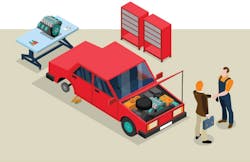For longtime industry consultant Cecil Bullard, one topic often comes up in his conversations with shop operators: pricing effectively.
And with his many years in the automotive business—from owning his own shops to founding his own consulting company, the Institute for Automotive Business Excellence—one of his specialties is helping his clients understand the financials of the business.
So, Bullard says, when it comes to pricing your services, a big concern for shop operators is customer loyalty—specifically the misconception that the two directly correlate. Customer loyalty is derived from many aspects of operations, and while pricing your services is one key, it’s not the only element.
Bullard helped Ratchet+Wrench break down the key factors in pricing your labor to differentiate your business—and put it on a path to proper profitability.
Embrace a Relationship Model—Not a Discount Model.
According to Bullard, if your shop advertises discount coupons, oil change coupons or any similar promotions, then you’re running a discount shop.
If your shop’s advertising consists of marketing your warranty, loaner cars, car washes or value-added services, then you’re running a relationship-driven shop.
“When we want to talk about marketing, technically speaking, what I should do is match my business to the customer I want to do business with,” Bullard says. “[If you're running a discount shop], your average repair order is going to be lower and it’s going to be harder to sell because [customers] are going to be less likely to want to pay.”
The problem with the discount model, as Bullard explains, is that the discount customer is not profitable. That’s because a discount customer is focused on price, so they typically will not sign off on all repairs to fix the car the right way. Furthermore, those customers tend to not be loyal because they will go looking for a better discount the next time their vehicles need a service.
“You don’t price yourself for the customer. You price yourself for the business to be profitable,” he says. “Now, your best customers will pay more money and they don't care about price—within reason.”
Raise Prices to Match the Relationship Model.
Bullard says that the industry, as a whole, under prices its services by a minimum of 30 percent. While the average shop charges around $110–$120 per hour, it really should be at $170–$200 per hour, he says.
If you raise your prices $5–$10 dollars per hour, he says it’s likely that no one will ever notice except for you and your staff.
“We’re way underpriced and we’re not attracting good people and we’re not keeping people in business,” Bullard says. “The battle to survive in the automotive industry is being lost financially because we’re not able to or willing to charge what we need to charge.”
According to Bullard’s estimation, the cost of living has increased roughly 3 percent year over year for 75 years now. Thus, if a shop that charged $70 per hour for labor in 1980 increased its rate by 3 percent each year, that shop should charge $209 in 2017.
When it comes to customer loyalty, as mentioned earlier, it is very rare that a customer may notice such an incremental price increase. If they do notice, and you lose a customer over it, “then you’ve got the wrong people,” Bullard says.
A lot of the times, shop owners will feel as if they did something wrong when a customer asks them why they raised their prices—but that shouldn’t be the case. If you get asked, Bullard suggests having a reason to tell your customer, whether that be explaining that the cost of living has gone up or shop supplies have increased. Don’t be afraid to explain yourself to the customer.
Price to Meet the Correct Margins.
A crucial tip that Bullard gives is that, as a shop owner, you need to make at least 20 percent net profit. In addition, you need to pay your technicians a minimum of 40 percent of the effective labor rate.
This ultimately goes back to effectively raising your prices. Bullard puts it this way: First, you’re going to have to hire a technician. If you want a good technician, you’ll pay around $30 per hour in the majority of markets and with an additional loaded cost of 30 percent, that will ultimately bring you to $39 per hour as your effective labor rate—the true cost to your business of that employee per hour. This means that you should be around $100 per hour to ensure your techs make 40 percent of the effective labor rate.
Bullard says there is a lot of paranoia surrounding charging $100 per hour for labor, which is why a lot of shops are in the $93–$97 per hour range. The reason for that paranoia is unfounded, he says.
However, Bullard recommends being closer to the $105 or $107 range to account for discounts and other things, which will inevitably bring you to the $100 range.
Improve the Perceived Value of Your Services.
To the customer, it’s not about the cost of the product; it’s about their perception of the value, Bullard says.
“So when I have a customer that’s complaining about the price, what they’re really telling me is that you didn’t give me enough to make me feel comfortable paying you this,” he says.
There are two things that ultimately differentiate you from other shops that can do the same jobs with the same parts from the same vendors: price (i.e., being the cheapest) or the perception of quality (quality of the shop, the work, the trust, etc.).
“If you’re the trusted shop, the one that has the perception of the quality, then those customers are not as price conscious,” Bullard says. “And I would say the majority of them aren’t price conscious at all. They just want a good job at a fair price.”
What makes a price fair? According to Bullard, it’s a variety of things and “fair is a relative term based on their perception.”
He says that a customer believes something to be fair when they feel confident that the job will get done right and result in a quality product. If they believe it to be fair, they will most likely pay whatever it takes to get that.
And because perception is key, Bullard says that out of the 120 shops he consults, the ones that are the most consistently successful are priced higher.
Since perception plays an important factor, it’s important that shop owners evaluate everything to ensure their shops convey that value.
“Everything matters: the sign, how you’re dressed, how you talk to people if you come out from behind the counter, if you put a smile on your face, if you shake their hand,” Bullard says.

